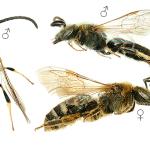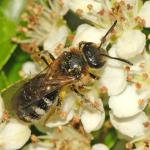Lasioglossum lugubris KIRBY 1802
Mainly confined to southern England, with a few records from further north. Not known from Scotland, Ireland or the Channel Islands. A local mining bee but sometimes abundant where found. A western Palaearctic species, the range extending from Britain to the Urals, and central Iberia to Iran.
This species is not regarded as being scarce or threatened.
Particularly associated with calcareous grassland; occasionally open woodland on chalk, wooded heathland and fenland.
Females from mid April to late September; males early July to September.
Nesting habits are apparently largely unknown. In Germany, the species is stated to be "solitary" (i.e. non-social) (Westrich 1989).
Lesser celandine (Ranunculus ficaria), broom (Cytisus scoparius), plum (Prunus domestica), wild parsnip (Pastinaca sativa), wild carrot (Daucus carota), willow (Salix species), speedwell (Veronica species), guelder-rose (Viburnum opulus), tormentil (Potentilla erecta) and ragwort (Senecio species).
No information available.
2002



